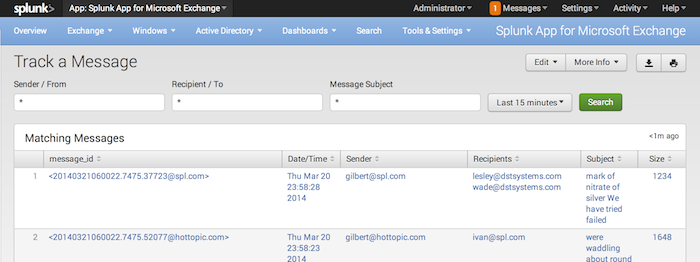Track a Message
This page allows you to find a single message among all messages that have passed through the Exchange system. It then allows you to find all events that concern the message.
How to use this page
- To begin tracking a message, enter as much detail as possible into the "Sender / From," "Recipient / To," and/or "Message Subject" fields above. To specify all of a certain category, use '*' (asterisk).
- Next, select an appropriate time period using the time range picker, then click "Search." The Splunk App for Microsoft Exchange displays the matching results below.
- Then, to track a matching message, click on it in the "Matching Messages" list. The Splunk App for Microsoft Exchange takes you to the "Message Routing" page, where it displays a full trace of the message through the Exchange system in the "Message Trace" panel, based on its message ID.
If you know a message's Message ID, you can enter it into the "Message ID" field on this page, select an appropriate date and time range using the time range picker, and click Search. The Splunk App for Microsoft Exchange displays the trace of the updated message.
If you click on a trace event in the Message Trace panel, the Splunk App for Microsoft Exchange brings up the base search that produced the event.
| Message Overview | Inbound Messages |
This documentation applies to the following versions of Splunk® App for Microsoft Exchange (EOL): 3.4.0

 Download manual
Download manual
Feedback submitted, thanks!